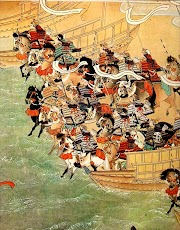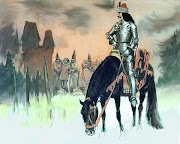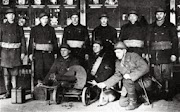In 1681 King Charles granted a similar charter to William Penn who had become the founder of the new colony. This was to be an event which sowed the seeds for a long and relatively bloody conflict for the rights and land deeds to settle what became Western Pennsylvania. Other important preceding conflicts or events in relation to the War in the Wyoming Valley included the First Anglo Dutch War 1652-1654, the massacre of Dutch Mennonites in Delaware 1664-1665, and King Philips War in New England, fought from 1675-1678.
The Yankee-Pennamite Wars truly began in the very early 1750’s in a frantic climate of land grabs as speculators, pioneers, and settlers arrived in Western Pennsylvania to claim land. Elsewhere throughout New Hampshire and Vermont, English and American colonials flocked to the forests of the region to claim plots of untouched land. These settlers were of both Yankee, those from Connecticut or New York heritage and from Pennsylvania (or Pennamite from the English Penn family who ruled the Pennsylvania colony) stock.
Chaos of a forest fight during the French & Indian War, 1754-1763
Colonial Rangers
Colonial American rangers were a very important military asset to the nations, states, and political movements who fought for control over the territories, and eventual states & provinces of North America. Rangers used a combination of skills most certainly inspired by the Native tribes of the North and Northwest of the America’s, like the Seneca, Mohawk, Oneida, and Onondaga of the Iroquois Confederacy. In fact many Ranger units or regiments of the French and later the British army were comprised primarily of friendly tribesman and colonial rangers (hunters/trappers) who knew the North American landscape well.
Depiction of the British colonial ranger, Robert Rogers (b.1731-1795)
The rangers of the colonial era fought with the accurate long rifles, flintlock pistols, tomahawks, swords, and hunting knifes. Many were used to great effect during French and Indian Wars for Great Britain, France, and the American colonists. Though rangers have entered into popular culture as romantic woodsman and citizen-soldiers, a fair amount of "rangers" were simply militia and provincial outfits of untrained or semi-trained levies. Very few ranger units of this era enjoyed the strategic successes or aplomb of Robert Rangers and Rogers' Rangers of French & Indian War fame.
Rogers' Rangers battling the French at La Barbue Creek in 1757
First Yankee Pennamite War 1769-1771
The First Yankee-Pennamite War began in 1769 when a Pennsylvanian settler and local scion Amos Ogden, refused to vacate his land and fortified blockhouse near the mouth of Mill Creek. After some skirmishing and the harassment of surveyors and Yankee settlers, a Connecticut army major by the name of John Durkee marched on Pennsylvania. He and his men erected the Forty Fort, named for the first 40 or so militia who came to defend Connecticut's land rights in the Wyoming Valley. Later a second redoubt, Fort Durkee, was built and reinforced with around 200 armed Yankees.
After Fort Durkee was seized by Pennamite militia in 1769 and Major Durkee arrested (later made prisoner in Philadelphia) another Connecticut officer and later Major-General, Zebulon Butler (b.1731-1795), a respected military man and veteran of the French & Indian Conflict, 1754-1763), was put in charge of the Connecticut army and militia forces in Pennsylvania. Butler used the services of Captain Lazarus Stewart and the "Paxton boys", known as the Paxton or Paxtang Rangers.
These ruffians were an irregular band of Pennsylvania bushwhackers and Indian fighters who had served on the frontier during the French & Indian conflict and who had fought and at times murdered the Native tribes of the Susquehanna and Juniata River valley throughout the 1760's-1770's. They were the outlaw foil to the high ideals and forest swashbuckling of Robert's Rogers. The most infamous incident perpetrated by the Paxton Boys was Conestoga Massacre of 1763, in which a few dozen of Stewart's men massacred twelve Native Americans, most of them women and children, in Lancaster County.
The Conestoga Massacre of 1763
An irregular of force of Paxton Boys and Yankees led Capt. Stewart, numbering less than one hundred men perhaps, struck back next in the First Yankee-Pennamite War, recapturing Fort Durkee with almost no opposition in February of 1770. Knowing that a large Pennamite miltia could overtake his small force rather easily, he sent a party to steal a four pound cannon from the blockhouse of Amos Ogden. Ogden got wind of this theft and swiftly returned to his blockhouse with an armed party, resolved to defend his property from Stewart's band.
What ensued next can be called the Siege of Ogden's Blockhouse; for five days the Paxton Boys and their Yankee allies took pot shots and fired their stolen cannon into the well defended fortress. At least one Yankee and five other men were wounded in this odd but hotly contested mini-siege. Major Durkee was released from prison and promptly returned to the valley, personally negotiating a surrender agreement with Ogden, who promptly fled after his surrender. His blockhouse and homestead were eventually plundered and burned by the vengeful Yankees in retaliation.
July 3, 1778, Massacre of most of Col. Zebulon Butler's force by British rangers and their Seneca & Iroquois allies
Second Yankee-Pennamite War
The Second Yankee-Pennamite War took place in 1775 beginning with skirmishes & ambushes between the settlers and militias of the Wyoming Valley. On Decembr 20 1775, war became unavoidable when most of the towns of the region levied militias to fight the Yankee expeditionary force. This short but bloody conflict ended at the Battle of Rampart Rocks on Christmas Day 1775.
On Sunday the 24th, Christmas Eve, Yankee and Pennamite forces skirmished throughout the day near the area known as Harvey's Landing. A carefully planned Yankee ambush led by Capt. Lazarus Stewart killed several Pennamites with the the leader of the Pennamite force, Colonel Plunkett, barely escaping with his own life as he and a few armed skirmishers attempted to cross Harvey's Creek in small boats.
Soldiers of the period on a cold and harsh winter march, 1771-1779
On Christmas day at Nanticoke Falls on the "Rampart Rocks", a Yankee regiment of 400 soldiers under Colonel Zebulon Butler, enemy "invaders" to the Pennsylvanians, defeated an attack of 500-700 Pennamite’s under Col. Plunkett supported by two loaned Pennsylvania cannons. The Yankee commander wrote in an account of the battle two days later to a confidant in the capital of Hartford that the Pennamite "Torie [wretches]" attacked when soon in sight of the Rampart Rocks and charged resolutely several times until beaten back by the Yankees deadly volleyed fire.
Third Yankee-Pennamite War
Following America’s War for Independence in 1783, the state of Connecticut had lost all sympathy and support for their far off claims in Pennsylvania. In 1782 the Decree of Trenton confirmed that the Yankees were illegally settled in the Wyoming Valley. Most of the Yankee settlers lost their rights as citizens of the Commonwealth of Pennsylvania and were stripped of their land claims as a result.
The Third Yankee-Pennamite War was fought and ended in 1783 after a Yankee army burned the fort at Wilkes-Barre, Pennsylvania and then abandoned the settlers of the Wyoming Valley, leaving them to become essentially refugees of war. Bloodshed and a very low intensity conflict of sorts would ensue for years after, not completely ending until the year 1799.
Part of the renewed Yankee campaigns from 1784-1790 began when 700-800 Yankee settlers were forcefully driven from their lands, losing their claims and for some their very lives following hardships in the wilderness after their eviction by the Pennamites. Despite General Butler's attempts to lobby for Senate and Congressional support any hope for a peaceful settlement seemed in vain. This was confirmed by the arrival of Ethan Allen (b.1738-1789) and small detachment of the Green Mountain Boys of Vermont in April of 1786.
Ethan Allen (b.1738-1789), a native of Connecticut, Allen was an American Patriot famous for capturing Fort Ticonderoga in 1775 during the War
Allen was born in Litchfield County, Connecticut becoming a Revolutionary War hero and a political force nationally as a former representative lobbying for the independence of the Vermont Republic. The Republic became an unofficial name given by historians of this period to the state when referring to Vermont's history between 1777-1791. Along with with his brother Ira (b.1751-1814) and some of his cousins he created an armed militia in the year 1770 after meeting at the Catamount Tavern in Old Bennington, Vermont. They were dubbed the Green Mountain Boys and soon his outfit took to harassing Yorkers (from the New York colony), Scottish settlers, and other interlopers who they felt were infringing upon their land rights. In time they were known as outlaws, with Ethan Allen as their leader, a man well versed in riding, shooting, and ranging through the woods of the Northeast.
During the Revolution, the Green Mountain Boy's and their leader gained fame for helping then Colonel Benedict Arnold (b.1741-1801) capture Fort Ticonderoga in May of 1775, soon after taking Fort Crown Point and Lake George, ensuring that a British invasion of New York or Connecticut via Canada would be foiled. Ethan Allen and his Green Mountain Boys might have played a greater part in the Revolution had he not been captured leading a raid on Montreal after his defeat at the Battle of Longue-Pointe in September 1775. Ethan Allan would remain in British custody until 1778, a year after Vermont had declared independence and become a de facto independent state.
During the Revolution, the Green Mountain Boy's and their leader gained fame for helping then Colonel Benedict Arnold (b.1741-1801) capture Fort Ticonderoga in May of 1775, soon after taking Fort Crown Point and Lake George, ensuring that a British invasion of New York or Connecticut via Canada would be foiled. Ethan Allen and his Green Mountain Boys might have played a greater part in the Revolution had he not been captured leading a raid on Montreal after his defeat at the Battle of Longue-Pointe in September 1775. Ethan Allan would remain in British custody until 1778, a year after Vermont had declared independence and become a de facto independent state.
Flag of the Vermont Republic
At the tail end of the Yankee-Pennamite conflict, Allan had come out of retirement to create a new skeletal regiment of Green Mountain Boys in the hopes of gaining considerable land from a deal between Vermont, Connecticut, and the Yankee settlers. Evidence suggests that he was willing to carve out another state in the region if the conditions were ideal.
This alleged plan never materialized and his trip to theWyoming Valley Pennsylvania sought a peaceful resolve to the conflict and granted the Yankee settlers and others the right to settle in the Wyoming Valley as citizens of Pennsylvania
This alleged plan never materialized and his trip to the
The Green Mountain Boys, 1776















